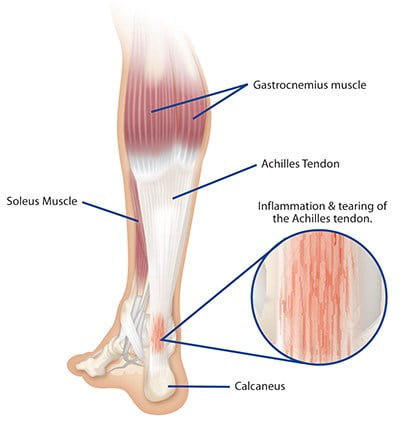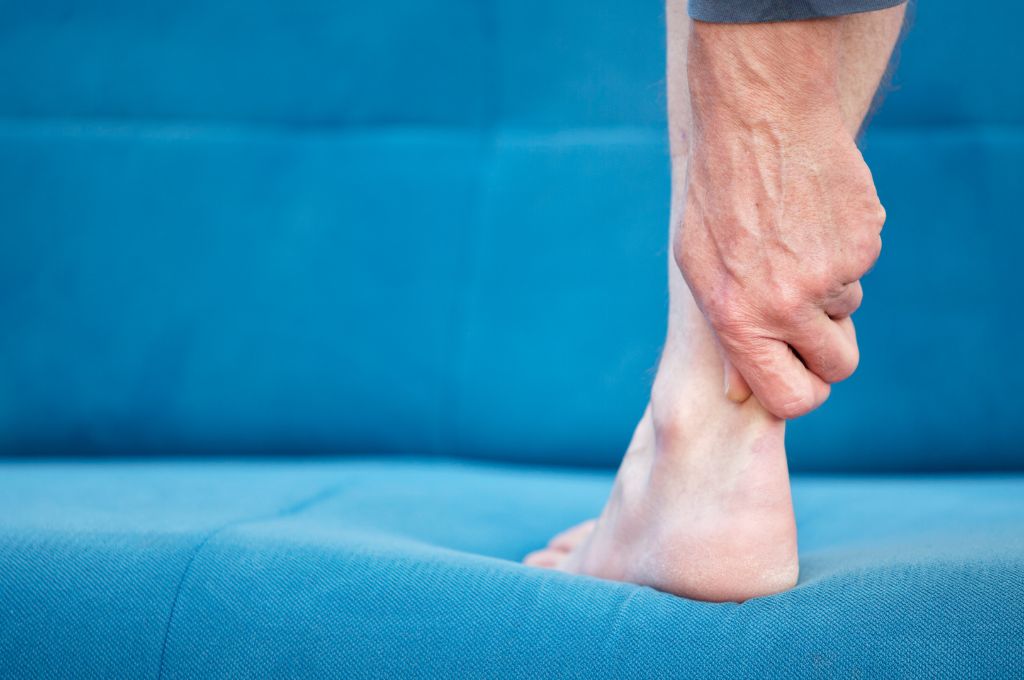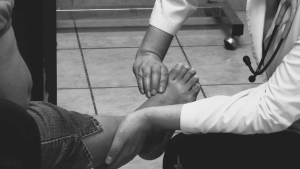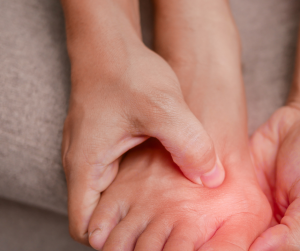The Achilles tendon is the largest and strongest tendon in the human body, connecting the calf muscles to the heel bone (calcaneus). Despite its strength, the Achilles tendon is susceptible to injuries, including at its insertion point at the back of the heel. This guide explains everything you need to know about Insertional Achilles Tendinopathy – a condition causing pain and swelling where the Achilles tendon attaches to the heel. Learn about causes, symptoms, diagnosis, treatment, and prevention below.
Anatomy and Function of the Achilles Tendon
Structure
The Achilles tendon is composed of collagen fibers that form a strong, rope-like structure. It originates from the gastrocnemius and soleus muscles in the calf and inserts onto the back of the heel bone.
Function
The primary function of the Achilles tendon is to transmit the force generated by the calf muscles to the heel bone, enabling plantarflexion (tip-toes) of the foot. This movement is crucial for activities such as walking, running, and jumping.
What causes achilles tendon insertion pain?
1. Insertional Achilles Tendinopathy
Insertional Achilles Tendinopathy is a common cause of pain and swelling at the Achilles tendon insertion. It results from degeneration in the tendon fibers near the heel bone, often due to overuse.
2. Achilles Tendonitis
Achilles tendonitis refers to inflammation of the Achilles tendon. It can occur at the mid-portion of the tendon or at its insertion. Insertional Achilles tendonitis specifically affects the area where the tendon attaches to the heel bone.
3. Retrocalcaneal Bursitis
The retrocalcaneal bursa is a fluid-filled sac located between the Achilles tendon and the heel bone, to prevent the tendon rubbing against the bone. Inflammation of this bursa, known as retrocalcaneal bursitis, can cause pain and swelling at the Achilles tendon insertion.
4. Haglund’s Deformity
Haglund’s deformity is a bony enlargement on the back of the heel that can irritate the Achilles tendon and cause pain and swelling at its insertion point.
5. Calcific Tendonitis
Calcific tendonitis occurs when calcium deposits form within the Achilles tendon near its insertion. These deposits can cause significant pain and inflammation.
6. Traumatic Injury
Direct trauma to the heel or excessive force applied to the Achilles tendon can result in pain and swelling at the insertion site. This may occur during sports activities or accidents.
7. Systemic Conditions
Systemic conditions such as rheumatoid arthritis, gout, and ankylosing spondylitis can also contribute to Achilles tendon insertion pain and swelling.
What are the symptoms of Insertional Achilles Tendinopathy (IAT)?
1. Pain
- Location: Pain is typically localised at the back of the heel, where the Achilles tendon inserts into the calcaneus.
- Nature: The pain can be sharp, burning, or aching, and may worsen with activity.
2. Swelling
Swelling around the Achilles tendon insertion is common and may be accompanied by redness and warmth. The swelling is low down, inside a shoe, rather than in the tendon’s main body a bit higher up in the “sock” area.
3. Stiffness
Stiffness in the Achilles tendon and heel, especially in the morning or after periods of inactivity, is a common symptom.
4. Tenderness
Tenderness to touch at the back of the heel is often present.
5. Reduced Range of Motion
Limited range of motion in the ankle joint, particularly during dorsiflexion, may occur due to pain and swelling.
6. Crepitus
A creaking or crunching sensation, known as crepitus, may be felt when moving the ankle.
Diagnosis of Insertional Achilles Tendinopathy and Achilles Swelling
1. Medical History
A thorough medical history, including details about the onset, duration, and nature of symptoms, as well as any previous injuries or underlying conditions, is essential for diagnosis.
2. Physical Examination
A physical examination involves assessing the affected area for pain, swelling, tenderness, and range of motion.
3. Imaging Studies
- X-rays: X-rays can help identify bony abnormalities, such as Haglund’s deformity or calcific deposits.
- Ultrasound: Ultrasound imaging provides real-time visualisation of the Achilles tendon and can detect inflammation, tears, and other soft tissue abnormalities.
- MRI: MRI offers detailed images of the Achilles tendon and surrounding structures, useful for confirming the diagnosis and assessing the severity of the condition.
Treatment Options for Achilles Tendon Insertion Pain and Achilles Swelling
Three Golden Rules:
- No bare feet and no flat shoes: Always use shoes with a slight heel lift / chunky heel – which relaxes the tendon.
- No strong stretches: These are excellent for Achilles pain in the main body of the tendon (and for plantar fasciitis) but frequently only aggravate the situation in cases of insertional Achilles tendinopathy.
- No shoes that rub: Always ensure that the back of shoes or straps do not rub. You should always be able to fit your finger between the heel and the shoe.
Conservative Treatments For Achilles Tendon Insertion Pain
a. Rest and Activity Modification
Reducing or avoiding activities that exacerbate symptoms is crucial for allowing the tendon to heal. Resting the affected leg and switching to low-impact exercises can help.
b. Ice Therapy
Applying ice to the affected area for 15-20 minutes several times a day can help reduce pain and swelling.
c. Compression
Using compression bandages or wraps can help minimize swelling and provide support to the tendon.
d. Elevation
Elevating the affected leg above heart level can aid in reducing swelling.
e. Nonsteroidal Anti-Inflammatory Drugs (NSAIDs)
NSAIDs, such as ibuprofen or naproxen, can help alleviate pain and reduce inflammation.
f. Physiotherapy
Physiotherapy plays a crucial role in the treatment of Achilles tendon insertion pain and swelling. A physiotherapist can design a tailored program that includes stretching and strengthening exercises, as well as techniques such as ultrasound therapy and deep tissue massage.
g. Orthotic Devices
Custom orthotic devices, such as heel lifts or shoe inserts, can help reduce strain on the Achilles tendon and improve foot alignment.
h. Extracorporeal Shock Wave Therapy (ESWT)
ESWT involves the application of high-energy shock waves to the affected area, stimulating healing and reducing pain.
Medical Treatments for Insertional Achilles Tendinopathy
a. Corticosteroid Injections
Corticosteroid injections can provide temporary relief from pain and inflammation. However, repeated injections should be avoided due to the risk of tendon weakening or rupture.
b. Platelet-Rich Plasma (PRP) Therapy
PRP therapy involves injecting a concentrated solution of platelets derived from the patient’s blood into the affected area to promote healing. There is no evidence that it works and it is, at best, an experimental treatment.
Surgical Treatments for Insertional Achilles Tendinopathy
a. Debridement
Debridement involves surgically removing damaged tissue, calcific deposits, or bony prominences that are causing irritation to the Achilles tendon.
b. Tendon Transfer
In cases of severe tendon damage, a tendon transfer procedure may be performed to replace the damaged portion of the Achilles tendon with a nearby tendon.
c. Gastrocnemius Recession
Gastrocnemius recession surgery lengthens the calf muscle to reduce tension on the Achilles tendon, which can be beneficial for patients with limited ankle dorsiflexion.
d. Haglund’s Deformity Resection
Surgical removal of Haglund’s deformity may be necessary to relieve pressure on the Achilles tendon and alleviate pain.
Rehabilitation and Recovery From Insertional Achilles Tendinopathy
1. Postoperative Care
Following surgery, patients typically need to wear a cast or walking boot to immobilise the foot and allow for healing. Gradual weight-bearing and physical therapy are initiated as the tendon heals.
2. Physical Therapy
Physical therapy is essential for restoring strength, flexibility, and range of motion. A physical therapist will guide the patient through exercises and stretches designed to improve tendon function and prevent recurrence.
3. Gradual Return to Activity
Patients should gradually return to their regular activities, starting with low-impact exercises and slowly progressing to higher-impact activities as tolerated.
Preventive Measures
1. Proper Footwear
Wearing well-fitting shoes with adequate arch support and cushioning can help reduce the risk of Achilles tendon injuries. Avoid high heels and shoes with rigid backs that can irritate the tendon.
2. Warm-Up and Stretching
Incorporating a proper warm-up routine and stretching exercises for the calf muscles before engaging in physical activities can help prevent tendon injuries.
3. Strengthening Exercises
Regularly performing exercises to strengthen the calf muscles and Achilles tendon can enhance tendon resilience and reduce the risk of injury.
4. Gradual Progression of Activity
Avoid sudden increases in the intensity or duration of physical activities. Gradually progress your activity level to allow the Achilles tendon to adapt and strengthen.
5. Cross-Training
Incorporating a variety of low-impact activities, such as swimming or cycling, into your exercise routine can help reduce strain on the Achilles tendon.
Frequently Asked Questions (FAQs)
1. What is the difference between Achilles tendonitis and Achilles tendinopathy?
Achilles tendonitis refers to acute inflammation of the Achilles tendon, while Achilles tendinopathy encompasses chronic degeneration in the tendon fibers, often without significant inflammation.
2. Can I continue to exercise with Insertional Achilles Tendinopathy or other achilles tendon pain & swelling?
It’s important to avoid activities that exacerbate symptoms. Low-impact exercises, such as swimming or cycling, can help maintain fitness without putting excessive strain on the tendon.
3. How long does it take to recover from Achilles tendon insertion pain and swelling?
Recovery time varies depending on the severity of the condition and the chosen treatment approach. Conservative treatments may take several weeks to months, while surgical recovery can take several months.
4. Is surgery always necessary for Achilles tendon insertion pain and swelling?
No, surgery is only rarely necessary. Conservative treatments are often effective in managing symptoms. Surgery is typically considered when conservative measures fail to provide relief.
5. Can Achilles tendon insertion pain and swelling recur after treatment?
Yes, recurrence is possible, particularly if underlying causes are not addressed. Adhering to preventive measures and following a proper rehabilitation program can help reduce the risk of recurrence.
6. Can stretching exercises help with Achilles tendon insertion pain and swelling?
Yes, stretching exercises for the calf muscles can help alleviate tension on the Achilles tendon and improve flexibility, which may reduce pain and swelling. However, some stretches are “too strong” and can exacerbate insertional Achilles pain.
7. What should I do if I experience sudden, severe pain in my Achilles tendon?
Sudden, severe pain in the Achilles tendon may indicate a rupture. Seek immediate medical attention to assess the injury and determine the appropriate course of treatment.
8. Are there any home remedies for Achilles tendon insertion pain and swelling?
Home remedies, such as ice therapy, rest, compression, and over-the-counter pain relievers, can help manage symptoms. However, it’s important to consult a specialist for a proper diagnosis and treatment plan.
9. Can weight loss help reduce Achilles tendon insertion pain and swelling?
Maintaining a healthy weight can reduce strain on the Achilles tendon and lower the risk of injury. Weight loss, even if you are only mildly overweight, may help alleviate symptoms.
10. How can I prevent insertional achilles tendinopathy if I have flat feet?
If you have flat feet, wearing supportive shoes and custom orthotic inserts can help improve foot alignment and reduce strain on the Achilles tendon, potentially preventing pain and swelling.
Conclusion
Insertional achilles tendinopathy, or any similar kind of achilles tendon insertion pain & swelling, can significantly impact daily activities and overall quality of life. Understanding the causes, symptoms, and treatment options is essential for effective management and recovery. Conservative treatments, such as rest, ice therapy, physical therapy, and orthotic devices, are often effective in alleviating symptoms.
In more severe cases, medical treatments and surgery may be necessary. Implementing preventive measures, such as proper footwear, stretching, and strengthening exercises, can help reduce the risk of Achilles tendon injuries and promote long-term tendon health.
Always consult a specialist for an accurate diagnosis and personalised treatment plan tailored to your specific needs.
Need expert help for Insertional Achilles Tendinopathy?
Book a consultation with our leading London foot and ankle specialists for accurate diagnosis and tailored treatment plans.


Matthew Solan
This article was written by Mr Matthew Solan, a consultant orthopaedic surgeon. He has been with LFAC since its formation in 2003.






